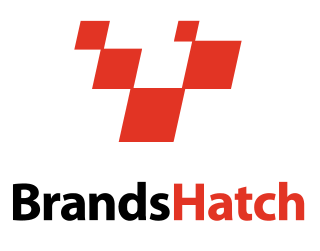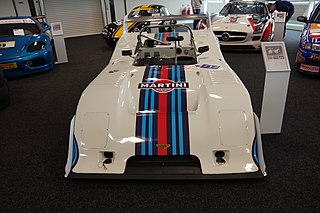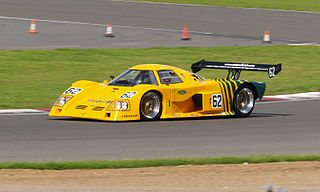Related Research Articles

Silverstone Circuit is a motor racing circuit in England, near the Northamptonshire villages of Towcester, Silverstone and Whittlebury. It is the home of the British Grand Prix, which it first hosted as the 1948 British Grand Prix. The 1950 British Grand Prix at Silverstone was the first race in the newly created World Championship of Drivers. The race rotated between Silverstone, Aintree and Brands Hatch from 1955 to 1986, but settled permanently at the Silverstone track in 1987. The circuit also hosts the British round of the MotoGP series.

The DFV is an internal combustion engine that was originally produced by Cosworth for Formula One motor racing. The name is an abbreviation of Double Four Valve, the engine being a V8 development of the earlier four-cylinder FVA, which had four valves per cylinder.

Brands Hatch is a motor racing circuit in West Kingsdown, Kent, England, United Kingdom. Originally used as a grasstrack motorcycle circuit on farmland, it hosted 12 runnings of the British Grand Prix between 1964 and 1986 and currently hosts many British and International racing events. The venue is owned and operated by Jonathan Palmer's MotorSport Vision organisation.

Group C was a category of motorsport, introduced by the FIA in 1982 and continuing until 1993. Group C applied to sports car racing, with Group A for touring cars and Group B for GTs.

The Mirage Lightweight Racing Car was a family of race cars built by J.W. Automotive Engineereing (JWAE) at Slough in England, initially to compete in international sports car races in the colours of the Gulf Oil Corporation.

The 1982 24 Hours of Le Mans was the 50th Grand Prix of Endurance, which took place on 19 and 20 June 1982. It was also the fourth round of the 1982 World Endurance Championship. As well as a significant anniversary, this was a watershed year for Le Mans, with the highly anticipated advent of the FIA's Group C regulations, the essence of which was to allow an open engine formula but a minimum weight for safety and a proscribed fuel allocation.

The 1981 24 Hours of Le Mans was the 49th Grand Prix of Endurance, and took place on 13 and 14 June 1981. It was also the eighth round of the World Endurance Championship of Drivers, and the fifth round of the World Championship for Makes.

The 1979 24 Hours of Le Mans was the 47th Grand Prix of Endurance, and took place on 9 and 10 June 1979. With no other major works cars this year, the Porsche team were the strong favourites to win. Their competition would be from Cosworth-powered Mirages and Rondeaus and a swarm of Group 5 and IMSA-class Porsche 935s. The other big talking point was the presence of Hollywood actor Paul Newman, driving for Dick Barbour Racing.

Warren Hughes is a racing driver from Newcastle, England.

The Sauber SHS C6 was a Group C prototype racing car built by Swiss manufacturer Sauber and engineering firm Seger & Hoffman, intended for competition in the World Endurance Championship and Deutsche Rennsport Meisterschaft series. Seger & Hoffman left the project later in 1982, leaving the car completely under Sauber's control.

The 1984 Sandown 1000 was an endurance motor race staged at the Sandown Raceway in Victoria, Australia on 2 December 1984. It was the eleventh and final round of the 1984 FIA World Endurance Championship and was the first FIA World Championship race to be held in Australia. It was to be the first of a three-year contract to race at Sandown, though the final two years would be cancelled.

The Aston Martin RHAM/1 was a highly modified Aston Martin DBS V8 racing car, developed by Robin Hamilton, built with the intention of racing at the 24 Hours of Le Mans. After development by Hamilton, RHAM/1 competed in the 1977 and 1979 24 Hours of Le Mans, finishing 17th overall and 3rd in the GTP class in the 1977 race. The car has also held the World Land Speed Record, for towing a caravan, at the speed of 124.91 mph.
The Romano WE84 is an Australian designed and built, mid-engined closed top racing car built to CAMS Group A Sports Car specifications. The car began its life as the Kaditcha K583 when it first appeared in the 1983 Australian Sports Car Championship and was built by the Queensland based Kaditcha owner and former McLaren engineer Barry Lock after he was approached by Brisbane accountant, property developer, timber mill owner and former speedway racer Bap Romano in 1981 with the idea of building a Le Mans type coupe. When the car first appeared in 1983, it was the first closed top Sports Car seen in Australia and looked like an FIA Group C Sports Car rather than the open cockpit Can-Am style cars of previous years. This led to the false belief that it was built to the Group C regulations
Jody Firth is a British racing driver, who most recently competed in the British GT Championship.

The Debora LMP296 was a Le Mans Prototype, built by Debora Automobiles in 1996 for use in the 24 Hours of Le Mans. The car was originally entered with a 2-litre turbocharged Cosworth straight-four engine, but several other engines were used in the car's three-year career. Two cars are known to have been built. In conjunction with the LMP297, the car helped Waterair Sport to the International Sports Racing Series SR2 Team's Championship in 1998. The LMP296 was updated into the LMP299 for 2000.

The Chevron B31 was a sports prototype racing car built by Chevron Cars Ltd in 1975, and initially used in the European 2-Litre Championship. The car was an evolution of the Chevron B26, and was initially fitted with a 2-litre Hart 420R straight-four engine producing 290 hp. However, various other engines were used; the car also ran with engines such as the 3-litre Cosworth DFV V8, the 2-litre Cosworth FVD/Cosworth BDG straight-four engines, and the 2-litre BMW M12 straight-four, amongst others.

The Ford C100 is a sports racing car, initially built and run as a Group 6 car, but later as a Group C car. The C100 was built by Ford in 1981, and initially featured a 4-litre Cosworth DFL V8 engine, which was replaced by a 3.3-litre version of the same engine in 1983, after the car had passed to private hands. Five cars are known to have been built. Although the cars were often very quick in qualifying, reliability problems plagued them, and restricted their successes to two Deutsche Rennsport Meisterschaft victories in 1982, and a single Thundersports victory in 1983.
The Dome RC83 was a Group C sports racing car built by Dome in 1983. A replacement for the RC82, which had been unsuccessful in its two 1982 entries, the car featured a 4-litre Cosworth DFL V8 engine and was developed in-house, unlike the RC82, which had a March Engineering chassis. One car was built. The car was replaced by the Dome 84C partway through the 1984 season, although the two cars did overlap during that year.
The Cheetah G603 was a Group C sports racing car built by Cheetah Automobiles in 1983. One car was built, and it was fitted with a 4-litre Cosworth DFL V8 engine; it had a short and fairly unsuccessful season before being replaced by the even less successful Cheetah G604 in 1984.

The Veskanda C1 is a one-off, Australian designed and built, mid-engined closed top racing car built in 1985 to CAMS Group A Sports Car specifications. Powered by a Chevrolet V8 engine, the car is generally regarded as the fastest sports car ever built in Australia and as of 2016 remains one of Australia's fastest race cars.
References
- 1 2 "Photos of Dome RC82". Racing Sports Cars. Retrieved 12 September 2013.
- ↑ "Silverstone 6 Hours 1982 – Photo Gallery". Racing Sports Cars. Retrieved 12 September 2013.
- ↑ "Silverstone 6 Hours 1982 – Race Results". Racing Sports Cars. Retrieved 12 September 2013.
- ↑ "Le Mans 24 Hours 1982 – Race Results". Racing Sports Cars. Retrieved 12 September 2013.
- ↑ "Le Mans 24 Hours 1983 – Race Results". Racing Sports Cars. Retrieved 12 September 2013.
- ↑ "1000 km Fuji 1983 – Race Results". Racing Sports Cars. Retrieved 12 September 2013.
- ↑ "Silverstone 1000 Kilometres 1984 – Race Results". Racing Sports Cars. Retrieved 12 September 2013.
- ↑ "Le Mans 24 Hours 1984 – Race Results". Racing Sports Cars. Retrieved 12 September 2013.
- 1 2 3 "All Results of Dome RC82". Racing Sports Cars. Retrieved 12 September 2013.
- ↑ "Le Mans 24 Hours 1986 – Race Results". Racing Sports Cars. Retrieved 12 September 2013.
- ↑ "Thundersports Oulton Park 1988 – Race Results". Racing Sports Cars. Retrieved 12 September 2013.